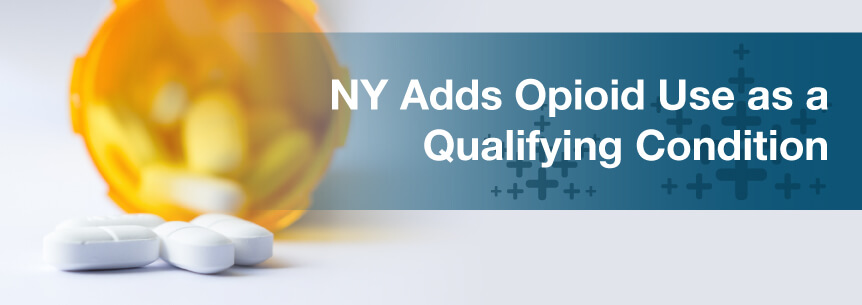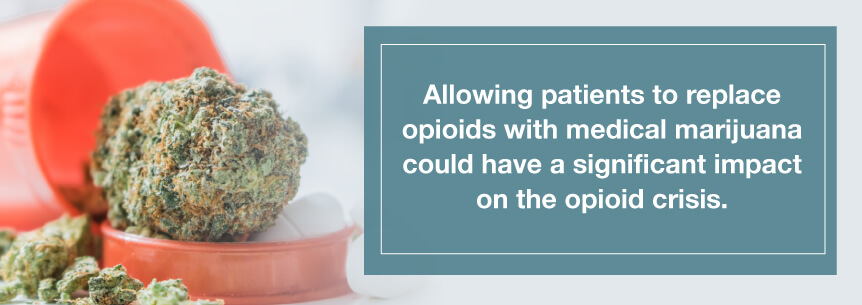
On June 18, 2018, the New York State Department of Health made an announcement that could improve the way we treat severe chronic pain. To combat the epidemic happening in their state and beyond, they added opioid use as a qualifying condition for medical marijuana. Discover what makes this development so revolutionary, as well as the implications it has for the future.
If you’ve been paying attention to our news and updates, you may have noticed Pennsylvania added opioid addiction as a qualifying condition for medical marijuana in April 2018. They were the first state ever to legalize cannabis medicine for opioid addiction treatment. This announcement makes New York the second, right? Well, no. The Department of Health is trying to target addiction before it even happens.
You see, an opioid-use disorder is entirely different from opioid use. Someone with an opioid-use disorder has symptoms related to opioid dependency and misuse. It has an official entry in the DSM that outlines its diagnosis. The term “opioid use” refers to the act of using opioids, regardless of related symptoms.
With opioid use as a qualifying condition, anyone with an opioid prescription can choose to take cannabis medicine instead.
On July 12, 2018, the New York State Department of Health expanded qualifying conditions to include any condition that opioids could be prescribed to treat. This makes New York, the first state to legalize medical marijuana for a range of conditions historically treated only with opioids. With both additions to the state’s medical marijuana program, they are becoming the nation’s leader in combating the opioid epidemic, by giving patients another treatment option.
Whether they take opioids or not, a large number of New York residents could experience the benefits of this addition. But naturally, people who take opioids will get the most out of it. Opioid medications are incredibly addictive — even when someone takes them as prescribed. Patients who use them often build up a tolerance, slowly making them less effective. Not taking opioids at all is the best way to avoid these adverse effects, and research shows medical marijuana can effectively relieve pain without the harmful consequences.
New York’s medical marijuana program can also grow thanks to this development, giving it more resources and making it more efficient. Restrictions on access and a short list of qualifying conditions have made it difficult for the state to bring in many members. In recent years, they’ve taken steps to make cannabis medicine more accessible through the program. For example, they added chronic pain as a qualifying condition in 2016. State Health Commissioner Howard Zucker said he feels optimistic about this change’s potential to improve the program.
The addictiveness of opioid painkillers has created a widespread epidemic throughout the United States. In 2016 alone, 42,249 people died from an opioid overdose. Out of those deaths, 40 percent involved commonly prescribed opioid drugs. It all began with a surge in opioid prescriptions in the 1990s that set off an increasing trend of prescription opioid overdose deaths in 1999. A major wave of heroin overdoses began in 2010, followed by a 2013 wave involving synthetic opioids. Regardless of the wave, all types of opioid medications have seen a spike in overdose rates.
New York state has experienced a crisis even more prominent than the national one. The countrywide rate of opioid-related overdose deaths was 13.3 per 100,000 persons in 2016. Meanwhile, New York’s rate was 15.1 — two percent higher than the national level. State opioid prescription rates went down during 2015 and became lower than the national number. However, they still had 51.3 prescriptions for every 100 people — a staggering amount.
Allowing patients to replace opioids with medical marijuana could have a significant impact on the opioid crisis. Instead of waiting for someone to become addicted before addressing the problem, the New York program takes a proactive approach. If people participate, the program update could lower the number of opioid prescriptions doctors write in the first place.

While fewer prescriptions mean a lower reliance on opioids for treatment, they also help people who don’t receive these medications. A lack of opioids in the house means people who aren’t intended to use them won’t have easy access to them. Plus, there aren’t as many circulating the illegal market, either. Unlawful access to opioids lowers overall when we use them to treat pain less often.
Additionally, reducing the frequency of opioid prescriptions lowers the money drug companies make on them. Evidence indicates the corporations behind painkillers like OxyContin are partially to blame for the opioid epidemic. Specific marketing techniques and strategies encouraged doctors to prescribe opioids, increasing addiction rates.
The response that other states will have to this development will likely depend on its success. The New York medical marijuana program has a difficulty recruiting patients in the first place. Throw in the lack of insurance coverage for cannabis medicine, and some might refuse to replace an opioid medication that their insurer covers. However, states have been legalizing marijuana for medical and recreational purposes at an increasing rate, and the medical marijuana movement is growing, too.
If this program change does end up reducing addiction and overdose rates, we would have high-quality evidence showing medical marijuana’s effectiveness against opioid addiction. With cannabis still considered a Schedule I drug on a federal level, we have scarce scientific evidence on the subject. Also, if Zucker’s hunch that this initiative will improve the New York program comes true, we’ll have even more evidence that cannabis medicine works.
At MarijuanaDoctors.com, we highly value the power of anecdotal evidence, but unfortunately, many scientific experts and government officials don’t. To them, data talks, and this new program could tell us a lot.
As a whole, the United States doesn’t consider marijuana legal. However, states like New York do — to an extent, anyway. The separation between federal and state laws makes navigating medicinal cannabis legislation complicated for even the most knowledgeable patient. To learn more about the options presented to New York patients, check out these resources:
Of course, you can’t beat the advice of a cannabis-friendly doctor or a dispensary staff member. Search for a medical marijuana professional near you today.
No Information on MarijuanaDoctors.Com should be used to diagnose, treat, prevent or cure any disease or condition. You can view our Full Disclaimer here.